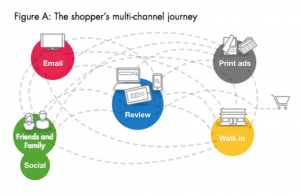On average, we conduct 12 billion searches per month on the web in the United States. (Comscore, July 2014) *Source
That’s 400 million searches per day. Most of these searches are performed by people like you and me looking for a solution to a problem or need, asking a search engine or a social network where to go, what to eat, what to buy.
Purchase paths are complex and unpredictable for the most part. We might start on a search engine, check a review site, ask our social network, or maybe it’s the other way around. Sometimes the time lag to purchase is minutes or as long as years. It could be a for a new shirt, a restaurant for tonight, or it might be for global management solution for the enterprise you work for.
Regardless of how big or small, fast or slow, we click, and eventually, we buy.
Now, let’s take a look behind the curtain, at the marketers and sales people scrambling around in hamster wheels cranking out creating content that appears during that search path with the right information at the right time. Our jobs are to their prayers in a New York Times article that sends them to the company’s website at which time they make a phone call, schedule an appointment and eventually spend XX dollars.
It’s not by chance; rather thanks to that PR firm you just hired. Everyone is excited. Awesome New York Times placement! The obligatory round of congratulatory emails begin with this (this is an actual email I was recently copied on):
Dear Client,
We are thrilled to share coverage of <brand name> in yesterday’s New York Times (Circulation: 2,517,307) as a result of our proactive outreach…
The estimated ad value of this placement is $6,947. The story also ran online on NYTimes.com (UMV: 70,574,252), and you may view it here.
Let’s dissect the few things wrong with this:
- It doesn’t address outcomes. Circulation numbers and unique monthly visits (UVM) are good to know but only scratch the surface. It doesn’t tell us how many people actually read it, and it certainly doesn’t give us any insight into the level of engagement or interest, or, even better, how many people clicked through, and spent X dollars?
- Estimated ad value really isn’t a meaningful metric. I won’t spend a lot of time on this as it’s a huge discussion point in the PR world and I thought, already a dead point. Giving an estimated ad value if that story space had been purchased is inaccurate since a third party testimonial is far more valuable and likely to influence action but even more importantly, if I’m the CEO of the business, I can’t really get my head around this. I want results, not marketing spend saved. Besides, I spent that money on the PR firm, instead of the ad for a reason!
- The fact the story ran online is an aside in this note. Oh, by the way, it also ran online…I know we all like to see our name in print but holy cow, those online stories will work for you for decades! They are awesome for your SEO (great valuable link from an authoritative site) and it will turn up in searches forever. The print version gets tossed in the trash.
Here is how this could have gone better:
Dear Client,
YAY! New York Times! Then go ahead and share circulation and unique monthly visits. Leave out ad equivalency and talk about the future: “It’s too soon to tell now, but we’ll be closely watching the analytics to see how much and what kind of traffic this story will be sending to the website.” (perhaps it sends to a campaign-specific landing page). “We’ll also look at how that traffic is engaging, i.e. how many pages they visit, time on site, and if they subscribe to that newsletter, sign up for that webinar, or make that purchase (You would insert your goals here). We’ll continue to report back.”
This implies that as part of our inbound marketing strategy to attract leads and convert them, we have thought ahead before we do our media relations and we have specific actions we want readers to take. We have a deep understanding of our Google Analytics or other analytics software and have set up goals so we can track conversions.
PRs little PR problem is in the reporting. If we can’t measure the right stuff and report back on meaningful metrics, it’s no wonder we’re the first to go when the CEO has to make cuts. It’s up to us to show our value.
[ssba]

Leave a Reply